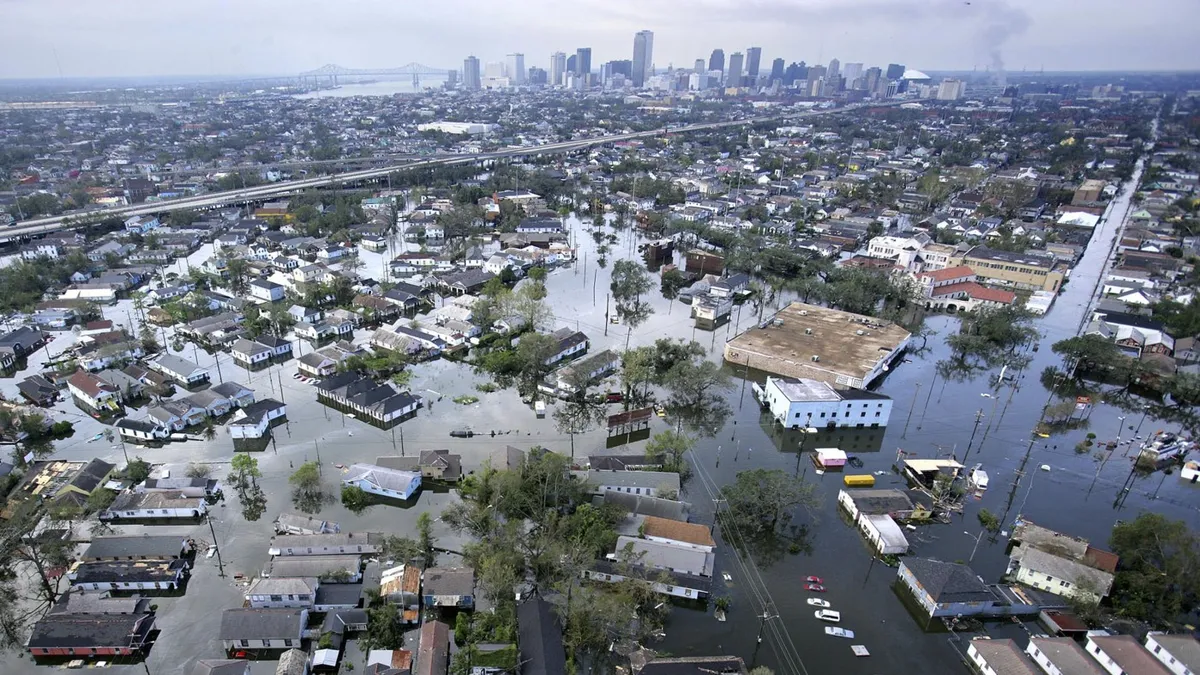
In the heart of New Orleans' Gentilly neighborhood, a small brick house stands as a poignant reminder of one of the most catastrophic events in U.S. history—Hurricane Katrina. This home is among the thousands that were severely impacted by the storm twenty years ago. Preserved by the organization Levees.org, founded by Sandy Rosenthal in the aftermath of the disaster, the house serves as a testament to the devastation and resilience of the community. Rosenthal invites visitors inside, revealing the remnants of chaos left in the storm's wake.
As you step inside, a trademark X can be seen on the wall—a symbol left by first responders during the search and rescue operations. Each mark carries significant meaning: the date of the inspection, the number of deceased found within, and any hazards like gas leaks or structural collapses. A musty smell permeates the air, intentionally recreated by artists to evoke the memories of survivors returning home after the floodwaters receded. Furniture is strewn about, with a piano turned upside down and a stuffed teddy bear covered in mud lying in the middle of the living room floor. While no one perished in this house, the tragedy of Hurricane Katrina claimed the lives of hundreds in others, as the storm surge overwhelmed the city, breaching levees and floodwalls.
Just a few doors down, Rosenthal's organization has set up an outdoor exhibit featuring a Hurricane Katrina timeline and a vibrant garden. A monarch butterfly flits among the milkweed, marking the site of a significant levee breach along the London Avenue Canal. Rosenthal recounts how a 20-foot section of floodwall crumbled, unleashing a torrent of water into the neighborhood. The home that once stood on this footprint was swept away, halted only by two massive oak trees. Visitors often enter in hushed reverence, treating the site as a memorial.
In a different part of New Orleans, the Lower Ninth Ward, Robert Green clings to a stark reminder of the past—his mother's short concrete staircase, the last remnant of her home, which was washed away when the floodwalls on the Industrial Canal collapsed. Green vividly recalls the harrowing moments when floodwaters surged to the second floor of the house within minutes. He points to a pink line on the ceiling, marking the water level, more than halfway up to the roof. “We had just five minutes to escape to the attic,” he recalls, describing how he and his family narrowly avoided drowning.
Despite the catastrophic impact of Hurricane Katrina, the disaster was not entirely unforeseen. In 2002, journalists Mark Schleifstein and John McQuaid of the New Orleans Times-Picayune published a ten-part series warning of the city's vulnerability to flooding. Their chilling narrative, titled “The Big One,” detailed how a significant hurricane could inundate New Orleans, predicting the very devastation that transpired. The city, with over half of its area at or below sea level, faced increasing threats from coastal erosion and wetland loss, leaving it exposed to the Gulf of Mexico.
As Hurricane Katrina approached in 2005, New Orleans was protected by an extensive system of levees and floodwalls, many of which experts deemed inadequate. Ivor Van Heerden, then co-director of Louisiana State University's Hurricane Center, had raised alarms about the levees' vulnerabilities. His concerns were met with skepticism, as officials insisted the levees met federal standards. A year prior to the storm, FEMA funded a disaster simulation called Hurricane Pam, which predicted catastrophic outcomes if a hurricane struck New Orleans. However, the seriousness of this simulation went largely unrecognized by federal agencies.
As Hurricane Katrina intensified into a Category 5 storm, New Orleans Mayor Ray Nagin declared a state of emergency two days before landfall, leading to a mandatory evacuation. While 80% of the population evacuated, an estimated 100,000 residents remained, many without the means to leave. The city had designated the Superdome as a shelter of last resort, but as the storm approached, it quickly became overwhelmed.
When the levees failed, the city began to flood, with reports emerging of people stranded on rooftops. In the Lower Ninth Ward, floodwall collapses led to desperate circumstances. Green and his family, like many others, found themselves on a rooftop, fighting for survival as their house floated away. Tragically, Green's mother and granddaughter were among the 1,400 lives lost during the storm.
Two decades after Hurricane Katrina, New Orleans continues to grapple with recovery. The city has regained about three-quarters of its pre-storm population, but many neighborhoods still bear scars of devastation, with vacant homes and overgrown lots serving as stark reminders of the past. The storm inflicted around $125 billion in damages, making it the costliest hurricane in U.S. history, and rebuilding the levee system has cost nearly $15 billion.
In reflecting on the lessons learned, many believe that adequate preparation and federal support are essential to mitigate future disasters. As the community honors those lost, the resilience of New Orleans shines through, embodying a spirit that refuses to be washed away.